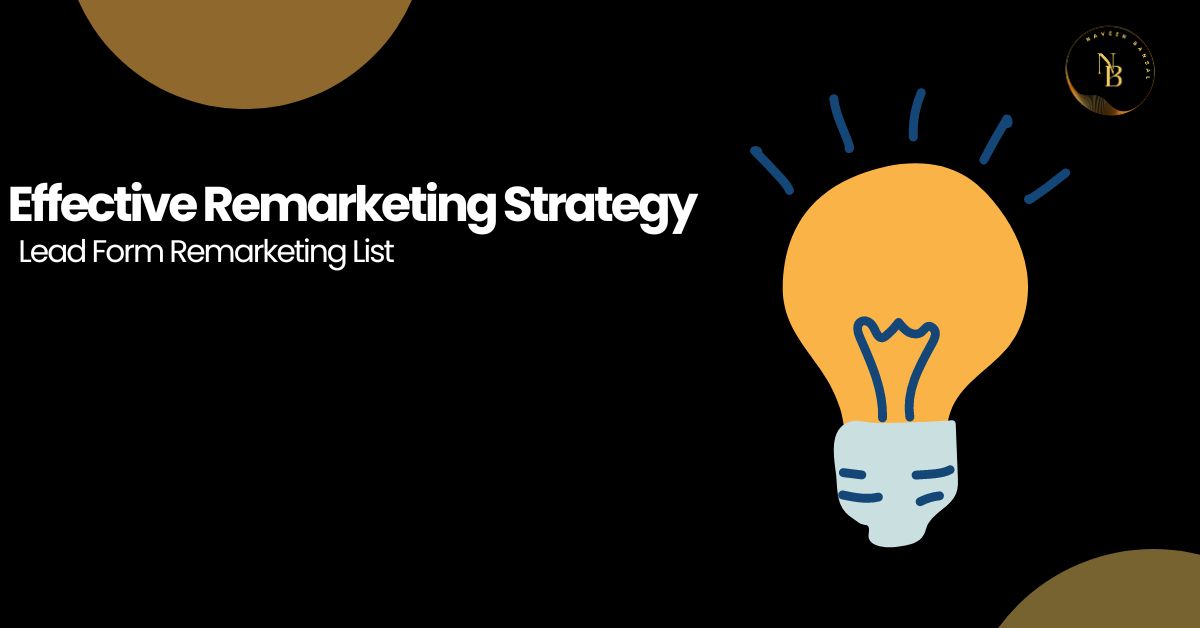Remarketing is a powerful strategy that allows businesses to re-engage with potential customers who have previously interacted with their brand. By leveraging remarketing lists, businesses can deliver targeted ads to these audiences, increasing the chances of conversion. In this article, we will explore the use of lead forms to create effective remarketing lists and the benefits it brings to businesses.
For creating compelling ads, optimizing landing pages, and utilizing data insights to maximize the impact of your remarketing efforts Consult Naveen Bansal Digital Marketing Consultant in India.
What is Remarketing?
Remarketing, also known as retargeting, is a digital marketing technique that involves targeting individuals who have already shown interest in a brand or its offerings. It allows businesses to deliver customized ads to these individuals across various platforms, reminding them of the brand and encouraging them to take further action.
Learn how to strategically target and personalize your messaging to reach users who have shown interest in your brand connect Naveen Bansal Digital Marketing Consultant in India.
The Importance of Remarketing Lists
Remarketing lists are essential for effective remarketing campaigns. By segmenting audiences based on their previous interactions, businesses can tailor their messaging and offers to align with their interests and needs. Remarketing lists enable businesses to deliver highly targeted ads to the right audience at the right time, maximizing the chances of conversion and ROI.
Using Lead Forms for Remarketing
Lead forms are a valuable tool for capturing user information and building remarketing lists. By using lead forms strategically, businesses can collect relevant data from potential customers and create segmented remarketing lists based on their preferences, intent, or stage in the buyer’s journey.
Benefits of Using Lead Forms for Remarketing
There are several benefits to using lead forms for remarketing:
Data Collection:
Lead forms allow businesses to gather valuable data, such as contact information, preferences, and specific interests. This data provides insights into potential customers, enabling businesses to deliver targeted ads and personalized experiences.
Segmentation:
Lead forms facilitate the creation of segmented remarketing lists. By categorizing potential customers based on their responses, businesses can target specific audience segments with tailored ads and messaging, increasing the chances of engagement and conversion.
Improved Ad Relevance:
By using lead form data to inform ad targeting, businesses can deliver highly relevant ads to potential customers. Relevant ads resonate better with the audience, increasing the likelihood of clicks, conversions, and positive brand perception.
Enhanced ROI:
By reaching out to individuals who have already shown interest in the brand, remarketing with lead forms can yield higher returns on investment. Remarketing campaigns tend to have higher conversion rates and lower cost per acquisition compared to traditional advertising methods.
Steps to Create a Remarketing List with Lead Forms
Creating a remarketing list with lead forms involves the following steps:
Choose a Lead Form Platform:
Select a lead form platform that integrates with your advertising and remarketing channels. Popular options include Google Ads, Facebook Lead Ads, and LinkedIn Lead Gen Forms.
Design the Lead Form:
Create a visually appealing and user-friendly lead form that captures the necessary information. Keep the form concise and focused, asking for relevant details without overwhelming the user.
Set Up Remarketing Tags:
Install the appropriate remarketing tags on your website or landing page. These tags allow you to track user interactions and build remarketing lists based on specific actions or behaviors.
Segmentation Strategy:
Determine your segmentation strategy based on the data you want to collect and the audience segments you want to target. This could include demographics, interests, engagement level, or any other relevant criteria.
Launch the Lead Form Campaign:
Promote your lead form through various channels, such as social media, email marketing, or paid advertising. Drive traffic to the lead form and encourage users to submit their information.
Create Remarketing Campaigns:
Once you have collected a sufficient number of leads, create remarketing campaigns tailored to each segment. Craft compelling ad copy and visuals that resonate with the audience’s preferences and intent.
Monitor and Optimize:
Continuously monitor the performance of your remarketing campaigns. Adjust your targeting, messaging, and ad creatives based on the data and insights you gather to maximize engagement and conversions.
Best Practices for Using Lead Forms in Remarketing
To make the most out of lead forms for remarketing, consider the following best practices:
Clear Value Proposition:
Clearly communicate the value and benefits users will receive by submitting their information through the lead form. Offer incentives or exclusive content to encourage participation.
Simplicity and Convenience:
Keep the lead form simple and easy to fill out. Minimize the number of required fields and streamline the submission process to enhance user experience and increase form completion rates.
Transparency and Privacy:
Clearly state your data usage and privacy policy. Assure users that their information will be treated securely and used only for relevant remarketing purposes.
Automated Follow-Up:
Set up automated follow-up sequences to engage with leads after they submit their information. This can include personalized emails, targeted ads, or other forms of communication to nurture the relationship and drive further action.
Conclusion
Using lead forms to create remarketing lists is a powerful strategy for businesses to re-engage with potential customers and drive conversions. By collecting relevant data and segmenting audiences, businesses can deliver targeted ads that resonate with the audience’s interests and needs. Leveraging lead forms in remarketing campaigns offers several benefits, including improved ad relevance, increased ROI, and better engagement. By following best practices and continuously optimizing their campaigns, businesses can maximize the power of lead forms and remarketing to achieve their marketing goals.

